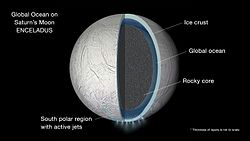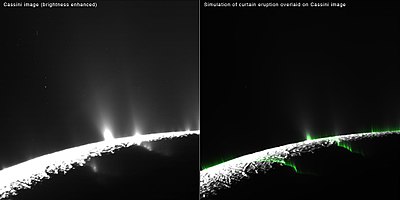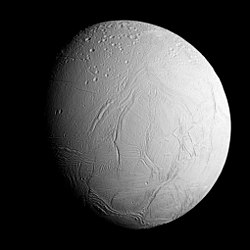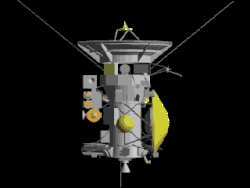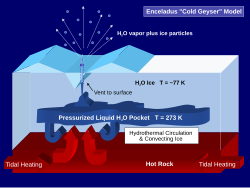PIA19059-SaturnMoon-Enceladus-OceanMethane-20150311
http://photojournal.jpl.nasa.gov/catalog/PIA19059
This illustration depicts potential origins of methane found in the plume of gas and ice particles that sprays from Saturn's moon, Enceladus, based on research by scientists working with the Ion and Neutral Mass Spectrometer on NASA's Cassini mission.
Scientists believe the plumes originate from an internal liquid-water ocean beneath the moon's south polar region. Recent findings from Cassini suggest hydrothermal activity as one of two likely sources of methane in the plume of gas and ice particles that erupts from the south polar region of Enceladus. The finding is the result of extensive modeling to address why methane, as previously sampled by Cassini, is curiously abundant in the plume.
Researchers with Cassini's Ion and Neutral Mass Spectrometer (INMS) determined that, at the high pressures expected in the moon's ocean, icy materials called clathrates could form that imprison methane molecules within a crystal structure of water ice. Their models indicated that this process could be so efficient at depleting methane from Enceladus' ocean that they still needed an explanation for the methane abundance in the plume.
In one scenario, hydrothermal processes supersaturate the ocean with methane. This could occur if methane is produced faster than it is converted into clathrates. A second possibility is that methane clathrates from the ocean are dragged along into the erupting plumes and release their methane as they rise, like bubbles forming in a popped bottle of champagne.
The authors agree that both scenarios are likely occurring to some degree, but they note that the presence of nanosilica grains, as documented by Cassini's Cosmic Dust Analyzer (CDA) instrument, favors the hydrothermal scenario.
The Cassini-Huygens mission is a cooperative project of NASA, the European Space Agency and the Italian Space Agency. NASA's Jet Propulsion Laboratory, a division of the California Institute of Technology in Pasadena, manages the mission for NASA's Science Mission Directorate, Washington. The Cassini CDA instrument was provided by the German Aerospace Center; the instrument team, led by Ralf Srama, is based at the University of Stuttgart in Germany. The INMS team is based at Southwest Research Institute, San Antonio, Texas.
For more information about the Cassini-Huygens mission visit http://saturn.jpl.nasa.gov and http://www.nasa.gov/cassini.Relevantní obrázky
Relevantní články
Enceladus (měsíc)Enceladus je šestý největší měsíc planety Saturn. Měsíc má v průměru téměř 500 kilometrů, což je přibližně desetina velikosti největšího měsíce Saturnu, Titanu. Enceladus je z většiny pokryt mladým a relativně čistým ledem, který odráží téměř veškeré sluneční světlo dopadající na jeho povrch. To má za následek extrémně nízkou teplotu povrchu pohybující se okolo -198 °C. I přes jeho malou velikost se na Enceladu nachází celá řada povrchových útvarů od starších oblastí silně posetých impaktními krátery po novější útvary vzniklé v posledních 100 milionech let. Rozsáhlou geologickou aktivitu vyvolávají patrně slapové síly planety Saturn, podobně jako u Jupiterových měsíců Io a Europa, protože vlastní významné zdroje tepla z radioaktivního rozpadu Enceladus s ohledem na svou velikost mít nemůže. Předpokládá se, že k zahřívání přispívá i rezonanční vazba Enceladu s měsícem Dione v poměru 1 : 2, což vyvolává uvnitř obou měsíců dodatečné slapové síly, a spolupůsobit může i měsíc Mimas. Vliv slapových sil by však nestačil k roztavení ledu, proto se vědci domnívají, že nitro Enceladu musí obsahovat i jiné těkavé látky s nízkým bodem varu. Na ledovém povrchu lze rozpoznat nejméně pět různých typů terénů: četné deformace, trhliny a prolákliny, ale jen málo impaktních kráterů, z nichž jsou mnohé přetvořené plastickým tečením povrchových vrstev měsíce. Největší kráter má průměr asi 35 km. Z jejich absence je tak zřejmé, že povrch je relativně mladý. .. pokračovat ve čtení


